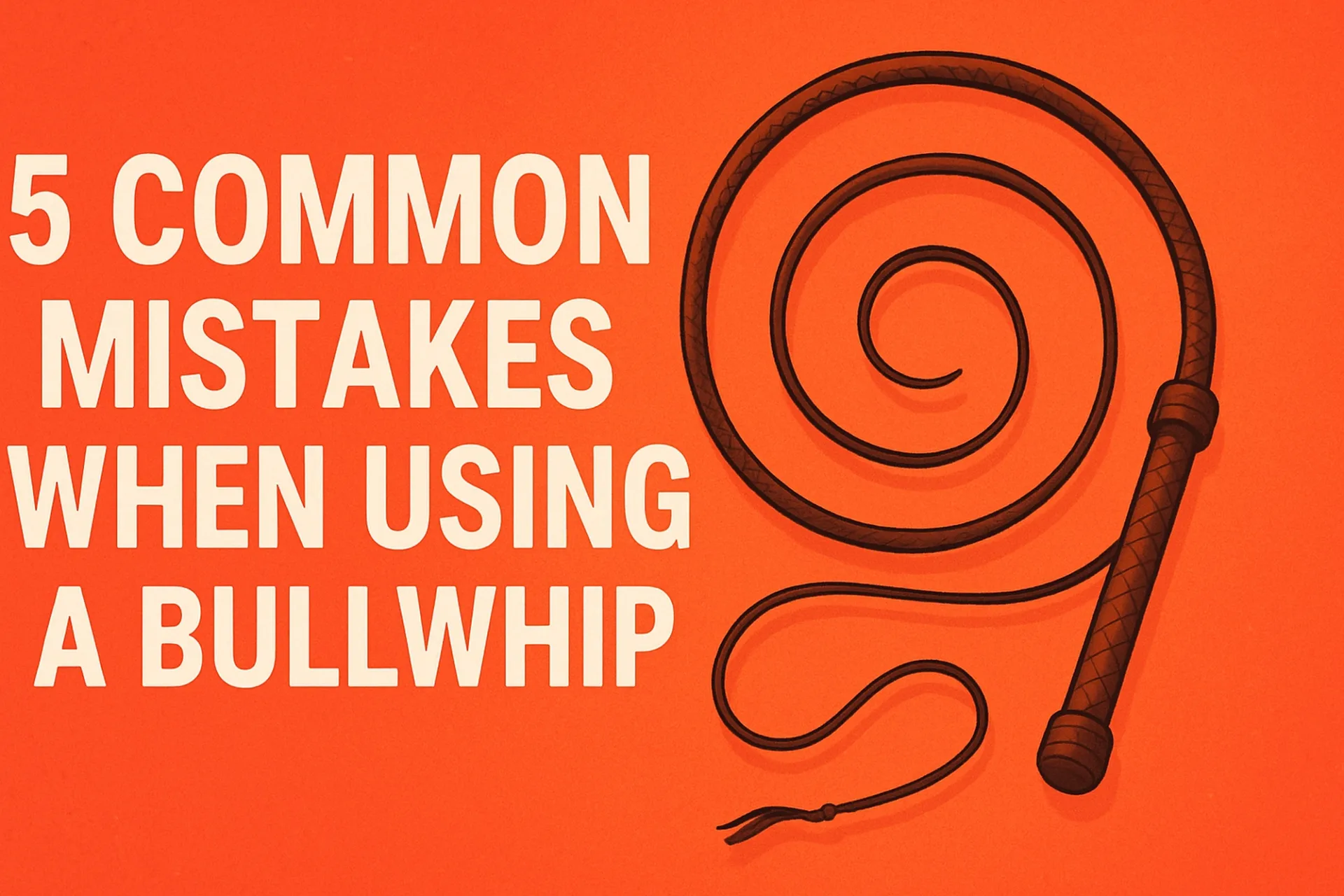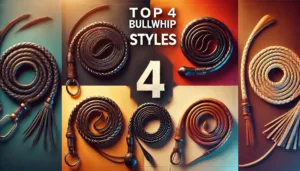Table of Contents
ToggleIntroduction: Don’t Let the Bullwhip Bite Back
The bullwhip is a classic symbol of skill, power, and precision. Whether you’re practicing whip cracking for fun, performance, or martial arts, mastering a bullwhip is more than just making it “crack.” Like any tool, it requires proper technique, safety awareness, and lots of practice. But if you’re just starting out, chances are you’re making at least one of the most 5 common bullwhip mistakes.
Let’s break down 5 Common Mistakes beginners make when using a bullwhip—and how you can avoid them to improve your control, confidence, and safety.
Before You Start Cracking
Before you grab your whip, make sure you’re fully prepared. Here’s a quick checklist:
A beginner-friendly bullwhip (6–8 feet) doesn’t choose the wrong whip length
Eye protection & gloves (optional but recommended)
Open, outdoor practice space
Comfortable, long-sleeve clothing
10–15 minutes of uninterrupted practice time
1. Poor Stance and Body Positioning
The Mistake:
Standing too stiff, off-balance, or positioning your body awkwardly when cracking the whip. This not only affects the effectiveness of your technique but increases the risk of injury.
The Solution:
Adopt a relaxed yet stable stance. Keep your feet shoulder-width apart, knees slightly bent, and your body loose. Your dominant arm should move freely while your non-dominant side stays balanced. Think of the motion as fluid—not forced.
🟢 Tip: Practice in front of a mirror or record yourself to check posture and motion flow.
2. Using the Wrong Whip Length
The Mistake:
Starting with a whip that is too long or too short. A long whip can be overwhelming and dangerous for a beginner, while a short whip might not allow you to develop a full range of motion.
The Solution:
Start with a 6 to 8-foot bullwhip, which provides a manageable length to learn basic cracks safely and effectively. Over time, you can experiment with longer or specialty whips.
To help you choose your first whip, read our full guide on How to Choose the Right Bullwhip for Beginners.
🟢 Bonus: Always choose quality-made whips from reputable sources—poor craftsmanship can lead to frustrating practice and dangerous backlashes.
🔗 Explore beginner-friendly bullwhips at Bantoro.com
3. Overpowering the Crack
The Mistake:
Beginners often assume they need to whip as hard and fast as possible to create a loud crack. This typically results in loss of control, fatigue, and injuries.
The Solution:
Focus on technique over strength. The crack is caused by the whip tip breaking the sound barrier—not sheer force. Use a smooth, snapping motion and let the whip do the work. Think of it as guiding, not yanking.
Want to understand the art behind the whip? Dive into The History and Art of Bullwhip Cracking for inspiration and insight.
4. Ignoring Safety Precautions
The Mistake:
Not wearing eye protection, whipping near others, or practicing in confined spaces. This is one of the most dangerous bullwhip mistakes and can result in serious injuries.
The Solution:
Always wear eye protection.
Choose a safe, open outdoor space with no people, pets, or fragile objects nearby.
Wear long sleeves if you’re a beginner—accidental self-whipping is common.
Check your surroundings and inspect your whip for damage before every session.
🟢 Safety First: The whip is a powerful tool. Treat it with the same respect you would a weapon or precision instrument.
5. Skipping Consistent Practice and Basics
The Mistake:
Jumping straight to advanced whip tricks without mastering the basics, or not practicing regularly. This often leads to plateauing and poor technique habits.
The Solution:
Master foundational cracks first: the cattleman’s crack, forward crack, and overhead crack.
Practice slowly and consistently rather than rushing through reps.
Use training guides and video tutorials from experts to refine your form.
🟢 Helpful Resource: Check out our Break-in Bullwhip and Mastering Your Whip on Bantoro.com.
Bonus Tip: Use a Training Target
Once you’re comfortable with the basic cracks, try adding a target to your practice routine. A hanging plastic bottle, paper plate, or a whip target stand can help improve your accuracy and timing. Start by aiming for consistent strikes on the same spot—this builds control faster than free-cracking alone.
Conclusion: Master the Bullwhip with Confidence
Bullwhips are thrilling and satisfying tools when used correctly—but frustrating and even dangerous when 5 common mistakes go unchecked. By refining your stance, using the right whip, focusing on technique, staying safe, and practicing smartly, you’ll be well on your way to cracking like a pro.
🔥 Ready to level up your whip game?
Check out our handpicked bullwhips, accessories, and beginner training resources at 👉 Bantoro.com
FAQs About Bullwhip Mistakes
Q1: Why does my whip keep hitting me or tangling?
A: This often happens due to poor timing or using excessive force. Slow down, refine your technique, and ensure you have enough space.
Q2: How loud should a whip crack be?
A: A whip crack should be sharp and loud—but it comes from speed and precision, not force. A good crack means your motion is correct.
Q3: Is it okay to practice indoors?
A: No. Bullwhips need ample space to be used safely. Always practice outdoors or in a designated training area.
Q4: How often should I practice to get better?
A: Start with 10–15 minutes daily focusing on one technique at a time. Consistent short sessions are better than long, infrequent ones.
Q5: What is the best bullwhip for beginners?
A: A 6–8-foot paracord or leather bullwhip with a firm handle is ideal for beginners due to its manageable length and control.
Q6: How to crack a whip for beginners?
A: Start with basic techniques like the cattleman’s crack using smooth, controlled motions—let the whip do the work, not your strength.
Q7: How to break in a new bull whip?
A: Use light practice sessions, uncoil the whip after use, and apply leather conditioner to gradually soften and shape it.
Q8: Where to buy a bullwhip near me?
A: You can order high-quality handcrafted bullwhips online from Bantoro.com — we ship across the UK, USA, and worldwide with a wide range of beginner and professional whips.
Q9: Can you whip yourself by accident?
A: Yes, many beginners accidentally hit themselves when learning to crack a bullwhip. This usually happens due to poor timing, incorrect stance, or overpowering the crack. That’s why beginners should practice in open spaces, wear protective clothing, and start slowly to build control
Q10: How to use a bullwhip
A: To use a bullwhip, focus on smooth technique rather than force. Hold the handle firmly, keep your stance relaxed, and guide the whip in a fluid snapping motion. Beginners should start with simple cracks like the Cattleman’s Crack and practice regularly in safe, open spaces.
Q11: Does a bullwhip really break the sound barrier?
A: Yes! The loud “crack” of a bullwhip happens because the tip moves faster than the speed of sound, creating a tiny sonic boom. This makes bullwhips one of the oldest man-made objects to break the sound barrier.
Q12: How dangerous are whips?
Bullwhips can be very dangerous if misused. They can cause cuts, bruises, or eye injuries if cracked too close to yourself or others. With proper training, safety gear, and awareness, they can be used safely for sport, performance, or martial arts.
Q13: what causes a whip to crack?
A: The whip crack comes from energy transferring down the whip’s length, accelerating the tip until it breaks the sound barrier. It’s not about brute force, but technique and the whip’s design.
Q14: Does a bullwhip hurt?
A: Yes, if you’re struck by the tip of a bullwhip, it can be painful and even break the skin. This is why eye protection, proper clothing, and safe training areas are highly recommended for beginners.



